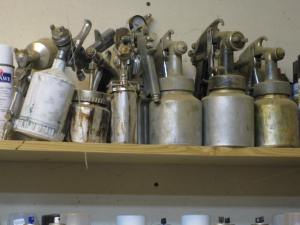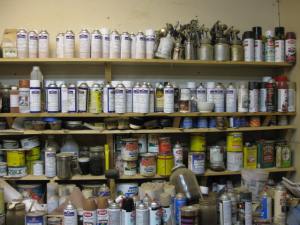In my finish room right now I have 8 spray guns and 2 air brushes and I haven’t used any of them in at least 3 years and maybe five. I can’t remember the last time I used one. Why you might ask, and this will make some people nuts, because I do most of my finishing with rattle cans. There are exceptions, one big exception is shellac, with shellac I either wipe it on or french polish. I use shellac whenever possible, I use a lot of shellac. I also use all kinds of other products when trying to match a finish for a repair. I always try to repair the original finish rather than refinishing. Much of what I repair is finished with lacquer so I also use a lot of lacquer.
Getting back to spraying, I started using spray cans for repair work where I was matching a small repaired area to preexisting finish, but their use has spread into finishing of new pieces. Why do I use spray cans instead of a spray system? When I finish a piece it usually goes something like this. 1. Seal with 1 or 2 coats of thin shellac. 2. Tone with from 2 to 4 different toners. 3. Another seal coat of shellac. 4. A coat of glaze. 5. Finally 1 to 4 coats of finish or French polishing. This means at a minimum of six different coats of spray and a maximum of up to 10 coats of spray. Which means 6 to 10 spray guns to clean. That’s why I have 8 spray guns. When I did this with spray guns I spent as much time cleaning spray equipment as I did finishing. Now if I was spraying kitchen cabinets all day long I would have the appropriate spray equipment set up and clean up once at the end of the day. But for small amounts of multiple products, spray cans save a great deal of time. Like any finishing procedure there is a learning curve but you can get a very good finish out of a spray can.
In the past you were limited in what was available in spray cans but that’s not the case today. Today you can get almost any finish in spray cans.
Cab lacquer, acrylic lacquer, pre-catalyzed lacquer, nitrocellulose lacquer, high solids lacquer, shellac, oil finish, dye toners, pigment toners, glazes, vinyls and sealers are just some of the products available in spray cans. There are also 8 or 10 different changeable spray tips available for spray cans. With spray cans there is no clean up, little waste, long shelf life and for me increased speed which means more income and in the long run less cost to my customers.



Is there a particular technique you find helpful to get the best results? Thanks.
Dylan, I will cover some techniques i use in the next post.
I’ve used spray can nitro lacquer for some of my guitars and haven’t gotten the best results w/o a lot of sanding (which with nitro still results in a great finish). I’m looking forward to any tips you post up.